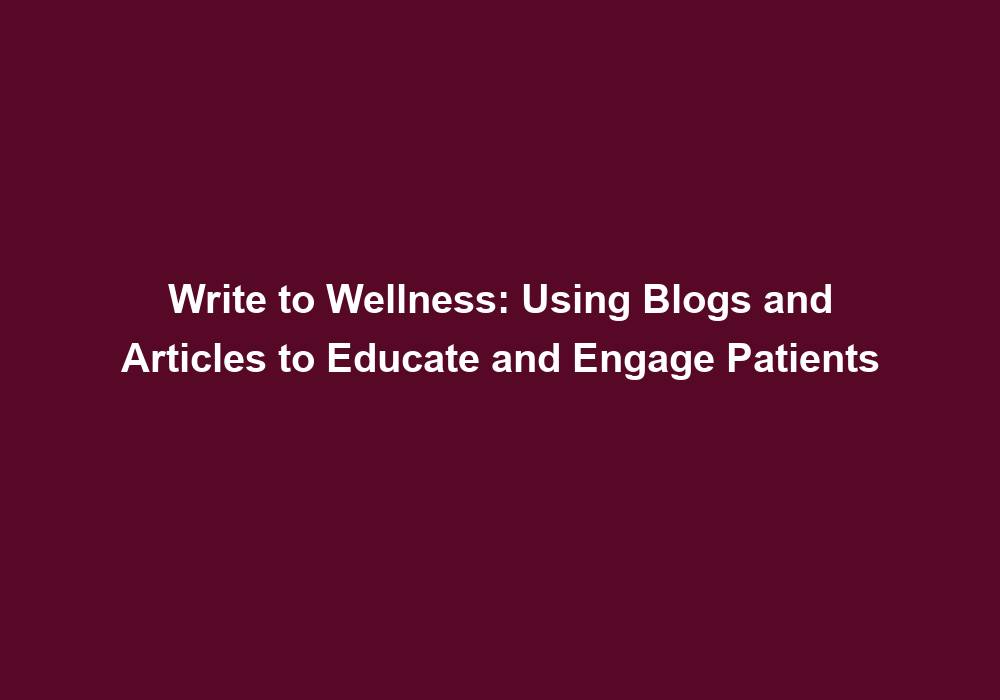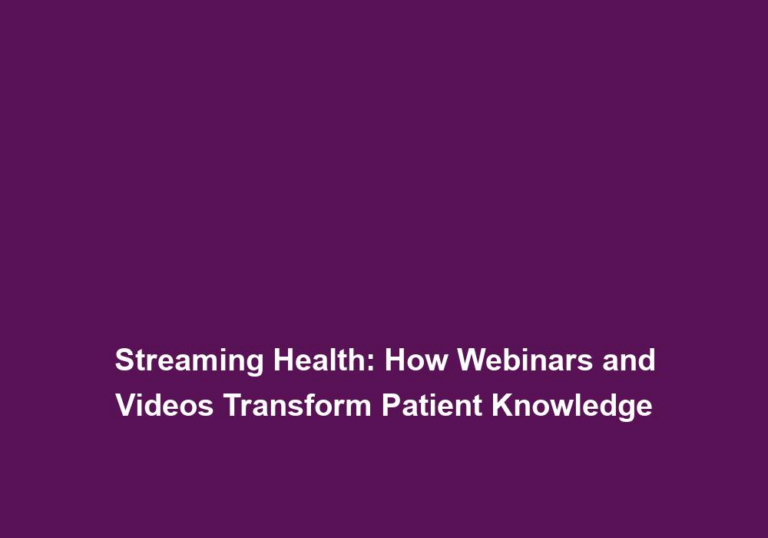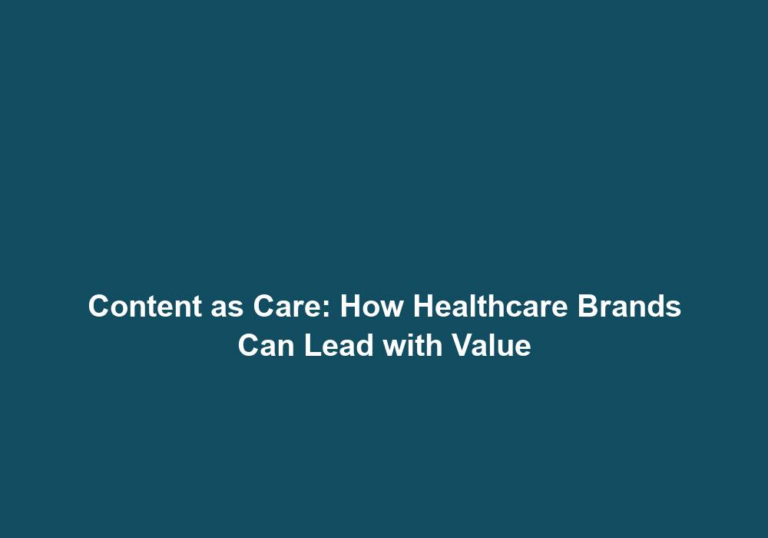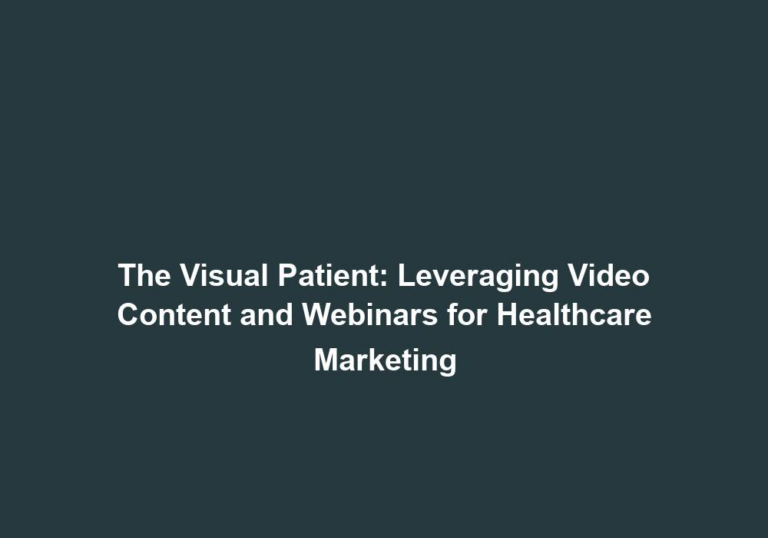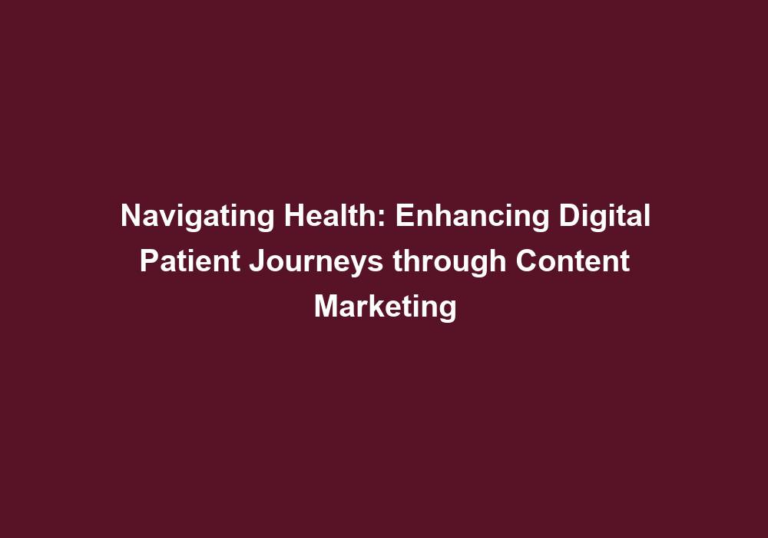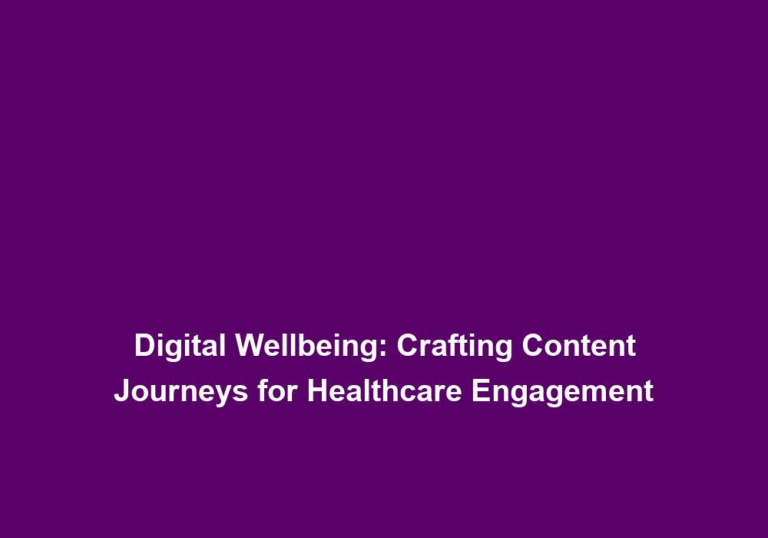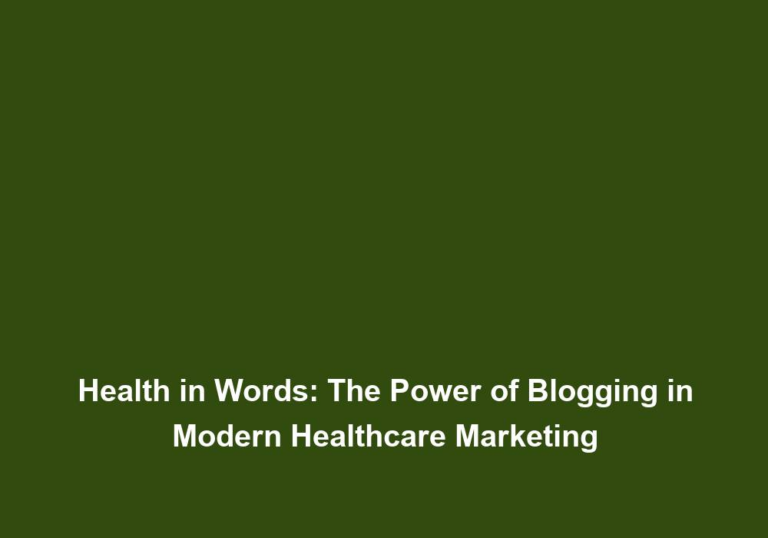Write to Wellness: Using Blogs and Articles to Educate and Engage Patients
In today’s digital era, healthcare professionals have fully embraced the power of online content to educate and engage patients. Blogs and articles have become essential tools for sharing valuable information, promoting wellness, and building strong patient-provider relationships. By leveraging the potential of search engine optimization (SEO), healthcare providers can effectively reach their target audience, establish credibility, and significantly impact patient outcomes.
The Importance of Patient Education
Patient education plays a critical role in improving healthcare outcomes. When patients are well-informed about their conditions, treatment options, and preventive measures, they become active participants in their own care. This empowerment can lead to better adherence to treatment plans, reduced healthcare costs, and enhanced overall well-being.
Expanding on this, patient education enables individuals to understand the underlying causes of their health issues and the available treatment options. By providing comprehensive information, healthcare providers can help patients make informed decisions about their care. Moreover, when patients are educated about preventive measures, they can take proactive steps to maintain their health and prevent future illnesses. This not only improves their overall well-being but also reduces the strain on the healthcare system.
Harnessing the Power of Blogs and Articles
- Creating Engaging Content: Blogs and articles provide healthcare providers with an opportunity to create engaging and informative content that resonates with their target audience. By addressing common health concerns, debunking myths, and sharing evidence-based information, providers can establish themselves as trusted sources of knowledge.
To further enhance patient engagement, healthcare providers can incorporate storytelling techniques into their content. By sharing real-life experiences and success stories, providers can create an emotional connection with their readers. This helps patients relate to the content on a personal level and encourages them to take action towards improving their health.
- Addressing Patient Queries: Many patients turn to the internet for answers to their health-related questions. By publishing articles that address frequently asked questions, healthcare providers can guide patients towards accurate information, dispel misconceptions, and alleviate concerns.
To effectively address patient queries, healthcare providers can organize their content in a question-and-answer format. This allows patients to quickly find the information they are seeking and encourages them to explore additional related topics. Additionally, providers can create comprehensive FAQ sections on their websites to serve as a centralized resource for patients seeking reliable information.
- Promoting Healthy Lifestyles: Blogs and articles can serve as a platform for promoting healthy lifestyle choices. From exercise tips to nutrition advice, healthcare providers can offer practical guidance that encourages patients to make positive changes in their lives.
To promote healthy lifestyles effectively, healthcare providers can provide actionable tips and step-by-step guides in their content. They can break down complex health topics into easily understandable information, making it more accessible to patients. Additionally, incorporating visually appealing infographics and videos can enhance patient engagement and make the content more shareable on social media platforms.
- Explaining Complex Medical Concepts: Medical jargon can often be overwhelming for patients. By breaking down complex medical concepts into simple language, healthcare providers can enhance patient understanding. Blogs and articles can help bridge the gap between medical professionals and patients, making healthcare information accessible to all.
To simplify complex medical concepts, healthcare providers can utilize analogies and real-life examples in their content. This allows patients to grasp the information more easily and apply it to their own situations. Additionally, using a conversational tone and avoiding technical terms whenever possible can further improve patient comprehension.
The Role of SEO in Healthcare Content Writing
Search engine optimization (SEO) techniques ensure that healthcare content reaches its intended audience. By optimizing the content for search engines, healthcare providers can increase its visibility and attract more patients. Here are some key SEO strategies for healthcare content writing:
- Keyword Research: Conduct thorough keyword research to identify the terms and phrases patients commonly use when searching for health-related information. Incorporate these keywords strategically throughout the content to improve its searchability.
Incorporating long-tail keywords, which are more specific and less competitive, can further enhance the visibility of healthcare content. These keywords often reflect patients’ specific health concerns and can help providers target their content to a niche audience.
- Meta Descriptions: Craft compelling meta descriptions that accurately summarize the content. These concise snippets appear in search engine results, influencing click-through rates and driving more traffic to the website.
In addition to accurately summarizing the content, meta descriptions should include relevant keywords to improve search engine visibility. Providers can also consider including a call-to-action in the meta description to encourage users to click through and read the full article.
- Heading Tags: Utilize appropriate heading tags (H2, H3, etc.) to structure the content and improve readability. Search engines consider headings as important indicators of the content’s relevance and hierarchy.
When using heading tags, healthcare providers should ensure that each heading accurately reflects the content beneath it. This helps both search engines and readers understand the organization and flow of the article. Additionally, incorporating keywords in headings can further optimize the content for search engines.
- Internal and External Linking: Incorporate relevant internal links to other articles or pages on your website to provide additional information and improve navigation. Additionally, include external links to reputable sources that support the information provided.
Internal linking not only improves website navigation but also helps search engines understand the relationships between different pages on a website. Healthcare providers can strategically link to related articles or resources to provide a more comprehensive understanding of the topic. When including external links, providers should prioritize reputable sources that enhance the credibility and reliability of their content.
- Optimized Images: Optimize images by adding alt text and descriptive filenames. This not only improves accessibility for visually impaired users but also helps search engines understand the content of the image.
When optimizing images, healthcare providers should use descriptive filenames that accurately reflect the image’s content. Including relevant keywords in the alt text can further improve the image’s visibility in search engine image results. Additionally, providers should ensure that images are properly compressed to minimize loading times and improve user experience.
- Mobile Optimization: Ensure that your website and content are mobile-friendly, as an increasing number of patients access healthcare information through their smartphones and tablets.
To optimize content for mobile devices, healthcare providers should prioritize responsive web design. This ensures that the content adapts to different screen sizes and provides a seamless user experience. Providers should also consider optimizing page loading speeds for mobile devices to minimize bounce rates and improve overall user satisfaction.
The Benefits of Utilizing SEO for Healthcare Content
By implementing SEO strategies in healthcare content writing, healthcare providers can reap numerous benefits:
- Increased Website Traffic: SEO techniques improve the search engine ranking of healthcare content, resulting in higher visibility and increased organic traffic to the website.
By optimizing content for relevant keywords and incorporating effective SEO strategies, healthcare providers can attract more visitors to their websites. This increased traffic not only enhances the reach of the content but also provides opportunities for patient engagement and conversion.
- Enhanced Patient Engagement: Well-optimized content that addresses patient needs and concerns fosters better engagement. Patients are more likely to share informative and engaging articles, resulting in increased brand exposure and credibility.
By consistently delivering valuable and optimized content, healthcare providers can build a loyal following of engaged patients. This engagement can extend beyond the website through social media sharing, comments, and discussions, further amplifying the impact of the content.
- Established Authority: Consistently providing high-quality and optimized content positions healthcare providers as authorities in their respective fields. This enhances credibility, leading to increased patient trust and loyalty.
When healthcare providers consistently deliver accurate, informative, and well-optimized content, they establish themselves as trusted sources of information. Patients are more likely to rely on these providers for their healthcare needs, resulting in stronger patient-provider relationships and improved patient outcomes.
- Improved Patient Education: SEO-driven content ensures that patients find accurate and reliable information easily. By offering valuable insights, healthcare providers can empower patients to make informed decisions regarding their health.
By implementing SEO strategies, healthcare providers can increase the visibility of their educational content, making it more accessible to patients seeking reliable information. This improves patient education, enabling individuals to make well-informed decisions about their healthcare and take proactive steps towards better health outcomes.
- Competitive Edge: By employing effective SEO strategies, healthcare providers can outperform competitors in search engine rankings, attracting more patients and building a strong online presence.
In an increasingly competitive digital landscape, effective SEO can give healthcare providers a competitive edge. By optimizing their content and website, providers can surpass competitors in search engine rankings, ensuring that their content is seen by a larger audience. This increased visibility can translate into more patient inquiries, appointments, and ultimately, a stronger position in the healthcare market.
In conclusion, leveraging blogs and articles to educate and engage patients is a powerful strategy for healthcare providers. By employing SEO techniques, healthcare content can reach a wider audience, improve patient education, strengthen patient-provider relationships, and ultimately enhance healthcare outcomes. Keeping patients well-informed and engaged through valuable online content is a significant step towards promoting overall wellness and ensuring patient satisfaction.

